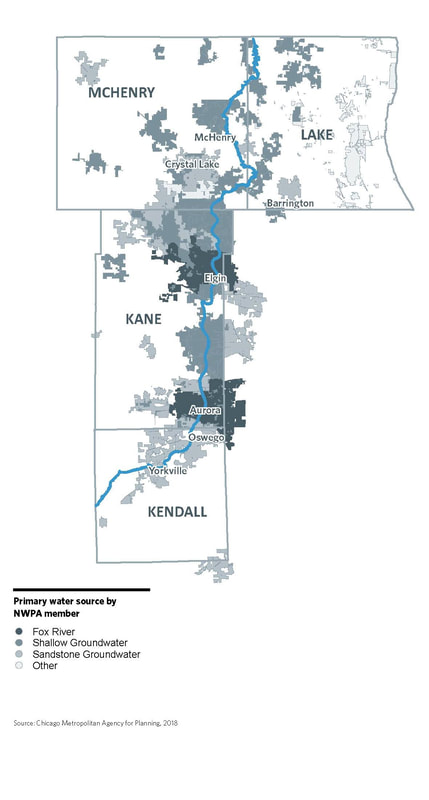Water Challenges |
|
Drinking water in the NWPA region comes from several different sources, including sand and gravel, shallow bedrock, and deep sandstone groundwater aquifers, as well as the Fox River. Growing population, habitat degradation, pollution, and climate change are placing challenges on each of these sources, impacting their viability as a long-term supply for drinking water.
Sandstone AquifersThe Illinois State Water Survey (ISWS) estimates that current withdrawals from sandstone aquifers are occurring at twice the natural recharge rate. In 2014, ISWS measured water levels in sandstone wells to understand the risk of desaturation for northern Illinois sandstone aquifers. A cone of depression is being observed in western Will County and northern Kendall County as a result of desaturation in the St. Peter sandstone aquifer. Excessive drawdown can result in decreasing well yields, increasing pumping expenses, and increases in salinity and oxygen that alter groundwater chemistry.
Current projections indicate that water demand will substantially increase in areas currently relying on the sandstone aquifers, including a 26 percent increase in the NWPA region alone. The resulting decline in groundwater levels raises concerns about the ability of groundwater wells to continue to provide the necessary quantity and quality of water to meet local water demands. If demand continues at its current rate or increases, further declines of this resource will likely force some communities and businesses to switch to alternate water sources, such as the Fox and Kankakee Rivers or Lake Michigan, and incur the associated costs. Shallow AquifersShallow aquifers -- sand and gravel and shallow bedrock aquifers -- are more susceptible to contamination because of their proximity to the land surface. Pollutants from lawns, businesses, and roads can infiltrate into the ground and impact water quality, especially in areas that are particularly permeable, such as sensitive aquifer recharge areas (SARAs). Recent research has revealed that shallow public water supply wells are experiencing increasing trends in chloride and total dissolved solids concentrations. A recent study found that shallow aquifers in Kane County had chloride concentrations that exceeded secondary drinking water standards. While more detailed studies in Illinois are needed, contaminants of emerging concern – like pharmaceuticals, pesticides, and microplastics – are a growing water quality issue.
Current projections indicate that water demand will increase in areas currently relying on shallow aquifers, including a 21 percent increase in the NWPA region alone. Withdrawals from shallow aquifers can exceed the recharge rate – particularly during drought conditions – which can result in greater conflicts between wells, additional streamflow capture, and degradation of local surface water quality. Climate change is anticipated to increase the frequency and severity of drought in Illinois. Fox RiverThe Fox River is a significant water source for the NWPA region, currently supporting water needs in Elgin and Aurora and has the potential to serve additional communities and private businesses. By 2050, Aurora and Elgin are projected to increase withdrawals by 10 percent from current levels. The river faces a number of challenges, including water quality and changes in flow conditions due to weather. Upstream land use practices and discharges to the river can bring pollutants, such as chlorides, nutrients, and siltation, all of which make treating the water more costly and difficult. As the climate changes, frequent heavy downpours and floods could increase the amount of sediment and contaminants transported to the river. Warmer surface water temperatures also can create conditions suitable for pathogens and harmful algal blooms, which make water more difficult and costly to treat for domestic use. Similar to shallow groundwater sources, contaminants of emerging concern – like pharmaceuticals, pesticides, and microplastics – are a growing water quality issue.
|
NWPA Primary Water Sources |

